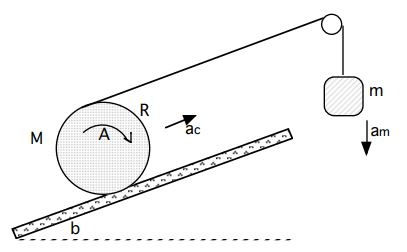Assignment:
Mass m= 8 kg is suspended from a cord which passes over a frictionless pulley then wraps tengentially on the surface of a uniform cylinder, mass M= 12 kg radius R = .66 m, on a plane inclined at angle b= 25 degrees from horizontal. As the suspended mass descends it gives angular acceleration A to the cylinder rolling it without slipping up the plane.
a. Develop a relationship between acceleration am, of the descending mass, and the linear acceleration ac, of the c. m. of the cylinder up the plane.
b. Find the accelerations am, of the descending mass, and the acceleration ac, of the c.m of the cylinder.
c. Find the friction force F on the cylinder at contact point. State whether this friction force is up or down the plane.
A mass m suspended on a cord which passes over a frictionless pulley then wraps on the surface of uniform cylinder, mass M radius R on a plane. As m descends it gives angular acceleration A to the cylinder, moving it up the plane. The plane makes angle b with horizontal.
